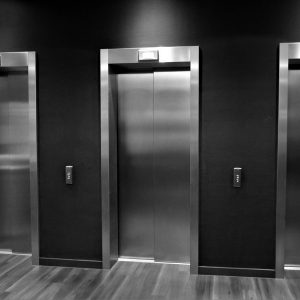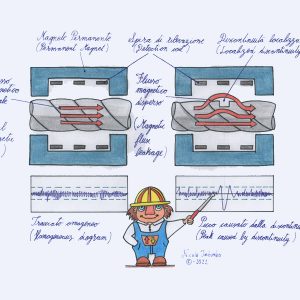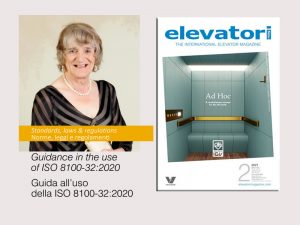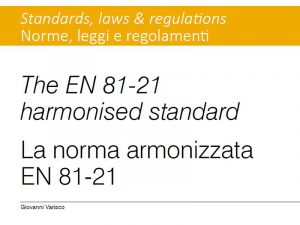Firefighter lifts and the operation in the event of a fire – Part 2
By Giovanni Varisco
Published on Elevatori Magazine Issue 2 Year 2019
In the present article, we remain focused on the two harmonised European standards that are of fundamental importance for lifts in buildings with a fire risk.
These are the EN 81-72 standard (Safety rules for the construction and installation of lifts – Special applications for passenger and freight lifts – firefighter lifts) and the EN 81-73 standard (Safety rules for the development and installation of lifts – Special applications for passenger and freight lifts – Behaviour of lifts in the event of fire.).
It is immediately evident that these harmonised standards are not necessarily to be applied to all lifts, yet, instead to those lifting systems that must respect and comply with essential fire code requirements and need to take into consideration the various national laws which are, nevertheless, different from Member State to Member State of the European Union.
In the present article, we remain focused on the two harmonised European standards that are of fundamental importance for lifts in buildings with a fire risk.
These are the EN 81-72 standard (Safety rules for the construction and installation of lifts – Special applications for passenger and freight lifts – firefighter lifts) and the EN 81-73 standard (Safety rules for the development and installation of lifts – Special applications for passenger and freight lifts – Behaviour of lifts in the event of fire.).
It is immediately evident that these harmonised standards are not necessarily to be applied to all lifts, yet, instead to those lifting systems that must respect and comply with essential fire code requirements and need to take into consideration the various national laws which are, nevertheless, different from Member State to Member State of the European Union.
Safety Requirements
The safety requirements for the EN 81-72 and EN 81-73 standards that we are examining are those types of lifts used to fight fires and are summarised below.
A refuge space must be present in front of every lift stop.
The National Authorities are entrusted with the responsibility of the standard fire safety characteristics required for buildings and refer to:
• the protection of refuge spaces,
• the separation of the lift shaft,
• the fire resistance of the various walls and landing doors,
• the connecting of the refuge spaces with the stairs of the building,
• the number and dimensions of firefighter lifts,
• the management of the electricity supply,
• etc.
Any normal lifts in the building are not required to remain operational in the event of a fire, but it is mandatory that a malfunction in these lifts shall not cause adverse effects on the workings of the firefighter lift.
The firefighter lift must have a secondary power supply whose source must be in a fire protected area, and the power supply (in general) must be suitably protected.
In the case of pressurised lift shafts, the EN 81-72 Standard indicates the factors that must be taken into consideration during the design stages.
Basic Requirements for Firefighting Lifts
The EN 81-20 standard must be fully respected along with the additions required by the EN 81-72 standard.
The dimensions of the car are subject to the requirements established by the National Authorities. Nonetheless, they may not be less than 1,100 mm (width) by 1,400 mm (depth), with a rated load of 630 kg, and with doors of at least a 900 mm clear entrance width.
For cars where the intended use is to accommodate the transport of stretchers, these dimensions must not be less than 1,100 mm (width) by 2,100 mm (depth), with a rated load of 1,000 kg. The performance levels of the firefighter lift must be such as to reach the furthest floor from the fire service access level within 60 seconds from the closing of the landing doors (for lifts with a trip length greater than 200 m the time can be increased by 1 second every 3 meters of the trip over 200 m).
Based on practical experience, the standard advises against speeds greater than 4.5 m/s.
The firefighter lift shall be designed to operate correctly during firefighting operations for a period equal to that required for the structure (example, for 2 hours). The Standard indicates the durability of the various electrical and electronic components, of the lift control operation, of the temperature detection sensors and the necessity for the system to operate also in a smoke-filled shaft.
Emergency exits must be provided from the lift shaft if two successive floor sills are more than 7.0 meters apart. Machinery spaces and lift shafts must not contain sprinklers.
Protection of electrical equipment (against water)
The standard sets the levels of protection according to the type of equipment and its location. The highest possible level of water allowed in the shaft pit is subject to agreements between the installer
and the person responsible for the construction (with the indication that it is no greater than 0.5 meters and that measures shall be taken to prevent the entry of water into the pit). The roof of the car
must also be designed in such a way as to prevent the accumulation of water above it.
Rescue of trapped firefighters in the liftcar
A trap door shall be provided in the roof of the car, and the passageway must not be obstructed by various fixtures, such as those necessary for lighting (if they are present, they must be easy to open and removable).
The opening of the trap door must interrupt and prevent the lift from operating; this function cannot be restored with the sole closure of the trap door but rather as a result of direct and voluntary action. The ladders used shall be per the EN 131-1 standard and have a safety contact that prevents movement of the lift if the ladder is not in its rest position. Their length shall be 1.0 meters greater than that of the height of the car (if they are intended as a means of rescue between the car and its roof).
The EN 81-72 Standard also indicates the characteristics of the ladder to be used to reach the landing door above the roof of the car.
If the rescue is carried out from outside the car, the Standard leaves the arrangements to the Local Authorities and indicates the possibility that they shall be adopted via means of portable ladders or safety ropes, nevertheless stipulating the installation of a ladder inside the car.
There is also a self – rescue system from inside the car through the trapdoor in the roof of the car, indicating the provision of any suitable stepping points to be employed for the ascent (if there is no special ladder).
In this last case, it is necessary to include a ladder that allows reaching the stop above that of the car roof: The appropriate pictograms shall be provided, and it is determined that self – rescue must be achievable from every possible stopping point of the car.
The plumbing between the machinery spaces and the lift shaft shall adopt the same fire safety protection as is required for the shaft structure.
Concerning the doors and with regards to the rescue procedures, they must be coupled and horizontal sliding doors. In the next issue of the magazine, we will continue to examine and consolidate the safety specifications of the EN 81-72 standard as well as the operating characteristics of the firefighting operation.





